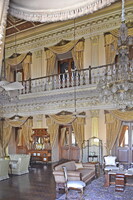| dc.coverage.spatial | Site: Hyderābād, Andhra Pradesh, India | en_US |
| dc.coverage.temporal | 1750-1869 (inclusive) | en_US |
| dc.creator | Mehrotra, Rahul | en_US |
| dc.date | 1750-1869 | en_US |
| dc.date.accessioned | 2016-06-21T19:10:30Z | |
| dc.date.available | 2016-06-21T19:10:30Z | |
| dc.date.issued | 1750-1869 | en_US |
| dc.identifier | 264673 | en_US |
| dc.identifier.other | archrefid: 3379 | en_US |
| dc.identifier.uri | http://hdl.handle.net/1721.3/180731 | |
| dc.description | Interior, Afzal Mahal, drawing room; Chowmahallat means "four palaces" in Urdu, alluding to the four different palace blocks. It was the seat of the Asaf Jahi dynasty and was the official residence of the Nizams of Hyderabad while they ruled their state. The palace remains the property of Barkat Ali Khan Mukarram Jah (born 1933), heir of the Nizams. While Salabhat Jung initiated its construction in 1750, it was completed by Asaf Jah V, in 1869, in a mix of Western and Mughal styles. The palace originally covered 45 acres (180,000 m2), but only 12 acres (49,000 m2) remain today; some of the buildings have been destroyed. What remains is centered in two courtyards, northern and southern. The Southern courtyard is the oldest, in Neoclassical stye, and contains four palaces; Afzal Mahal, Mahtab Mahal, Tahniyat Mahal and Aftab Mahal. The Northern courtyard is in Mughal style with Persian elements and contains two long administrative wings (Bara Imam and Shishe-Alat), the Khilwat Mubarak and the Roshan Bangla. The palace complex was restored 2005-2010 by Rahul Mehrotra Associates (RMA), overseen by Princess Esra. Source: Wikipedia; http://en.wikipedia.org/wiki/Main_Page (accessed 8/23/2015) | en_US |
| dc.format.medium | Italian marble; stucco; masonry | en_US |
| dc.rights | © Scott Gilchrist, Archivision, Inc. | en_US |
| dc.subject | architecture | en_US |
| dc.subject | rulers and leaders | en_US |
| dc.subject | Restoration and conservation | en_US |
| dc.subject | revival styles | en_US |
| dc.subject | Persian | en_US |
| dc.subject | Rajasthani | en_US |
| dc.subject | Indo-Saracen | en_US |
| dc.subject | Nineteenth century | en_US |
| dc.subject | Neoclassical | en_US |
| dc.subject | Mughal | en_US |
| dc.subject | Anglo-Mughal | en_US |
| dc.title | Chowmahalla Palace | en_US |
| dc.title.alternative | Chowmahallat | en_US |
| dc.type | image | en_US |
| dc.rights.access | Licensed for educational and research use by the MIT community only | en_US |
| dc.identifier.vendorcode | 1A2-IN-HY-FP-B34 | en_US |
| vra.culturalContext | Islamic Indian (South Asian) | en_US |
| vra.technique | construction (assembling) | en_US |
| vra.worktype | royal palace | en_US |
| vra.worktype | historic site | en_US |
| dc.contributor.display | restored by Rahul Mehrotra (Indian (South Asian) architect, born 1959) | en_US |

